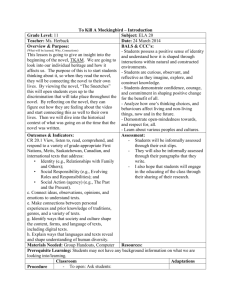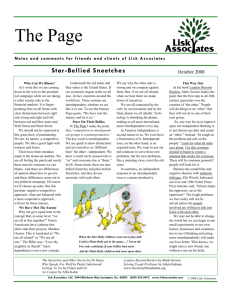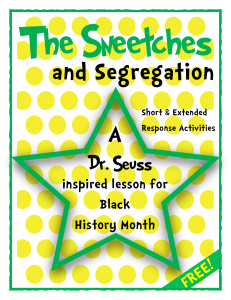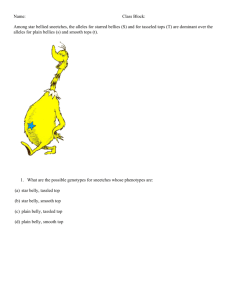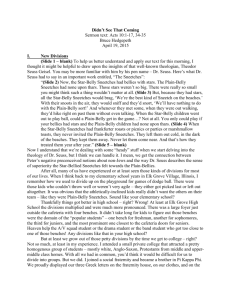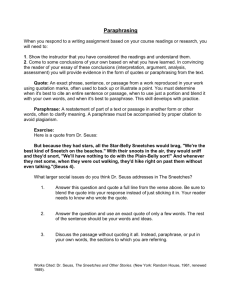English 10 Honors - Marlboro Central School District
advertisement
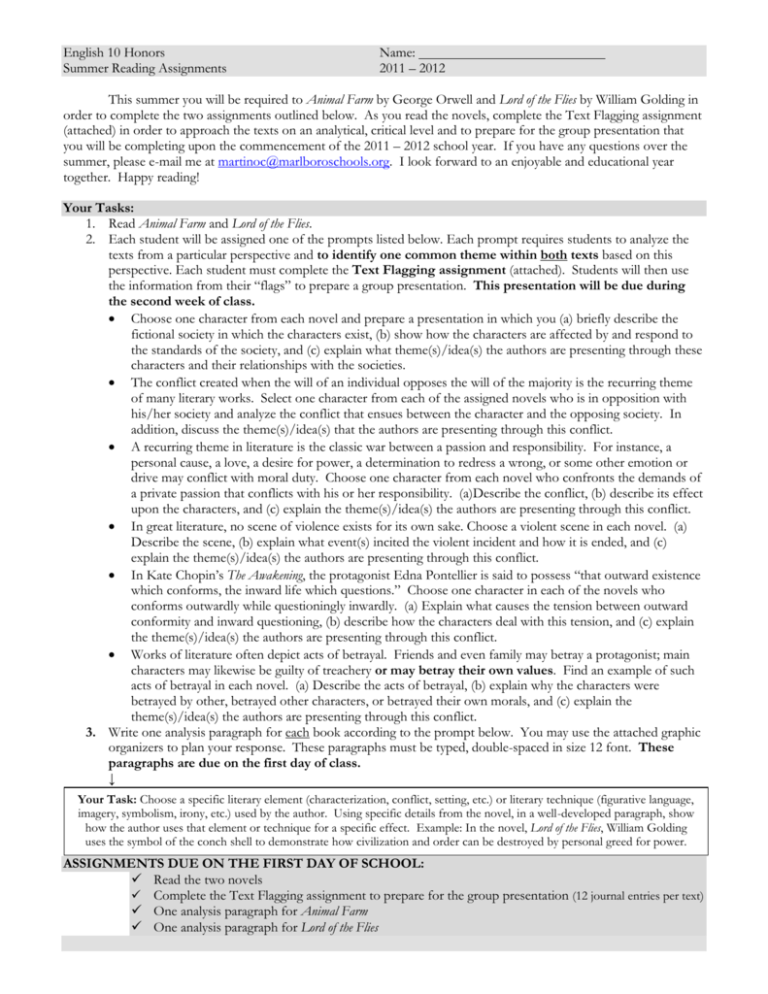
English 10 Honors Summer Reading Assignments Name: 2011 – 2012 This summer you will be required to Animal Farm by George Orwell and Lord of the Flies by William Golding in order to complete the two assignments outlined below. As you read the novels, complete the Text Flagging assignment (attached) in order to approach the texts on an analytical, critical level and to prepare for the group presentation that you will be completing upon the commencement of the 2011 – 2012 school year. If you have any questions over the summer, please e-mail me at martinoc@marlboroschools.org. I look forward to an enjoyable and educational year together. Happy reading! Your Tasks: 1. Read Animal Farm and Lord of the Flies. 2. Each student will be assigned one of the prompts listed below. Each prompt requires students to analyze the texts from a particular perspective and to identify one common theme within both texts based on this perspective. Each student must complete the Text Flagging assignment (attached). Students will then use the information from their “flags” to prepare a group presentation. This presentation will be due during the second week of class. Choose one character from each novel and prepare a presentation in which you (a) briefly describe the fictional society in which the characters exist, (b) show how the characters are affected by and respond to the standards of the society, and (c) explain what theme(s)/idea(s) the authors are presenting through these characters and their relationships with the societies. The conflict created when the will of an individual opposes the will of the majority is the recurring theme of many literary works. Select one character from each of the assigned novels who is in opposition with his/her society and analyze the conflict that ensues between the character and the opposing society. In addition, discuss the theme(s)/idea(s) that the authors are presenting through this conflict. A recurring theme in literature is the classic war between a passion and responsibility. For instance, a personal cause, a love, a desire for power, a determination to redress a wrong, or some other emotion or drive may conflict with moral duty. Choose one character from each novel who confronts the demands of a private passion that conflicts with his or her responsibility. (a)Describe the conflict, (b) describe its effect upon the characters, and (c) explain the theme(s)/idea(s) the authors are presenting through this conflict. In great literature, no scene of violence exists for its own sake. Choose a violent scene in each novel. (a) Describe the scene, (b) explain what event(s) incited the violent incident and how it is ended, and (c) explain the theme(s)/idea(s) the authors are presenting through this conflict. In Kate Chopin’s The Awakening, the protagonist Edna Pontellier is said to possess “that outward existence which conforms, the inward life which questions.” Choose one character in each of the novels who conforms outwardly while questioningly inwardly. (a) Explain what causes the tension between outward conformity and inward questioning, (b) describe how the characters deal with this tension, and (c) explain the theme(s)/idea(s) the authors are presenting through this conflict. Works of literature often depict acts of betrayal. Friends and even family may betray a protagonist; main characters may likewise be guilty of treachery or may betray their own values. Find an example of such acts of betrayal in each novel. (a) Describe the acts of betrayal, (b) explain why the characters were betrayed by other, betrayed other characters, or betrayed their own morals, and (c) explain the theme(s)/idea(s) the authors are presenting through this conflict. 3. Write one analysis paragraph for each book according to the prompt below. You may use the attached graphic organizers to plan your response. These paragraphs must be typed, double-spaced in size 12 font. These paragraphs are due on the first day of class. ↓ Your Task: Choose a specific literary element (characterization, conflict, setting, etc.) or literary technique (figurative language, imagery, symbolism, irony, etc.) used by the author. Using specific details from the novel, in a well-developed paragraph, show how the author uses that element or technique for a specific effect. Example: In the novel, Lord of the Flies, William Golding uses the symbol of the conch shell to demonstrate how civilization and order can be destroyed by personal greed for power. ASSIGNMENTS DUE ON THE FIRST DAY OF SCHOOL: Read the two novels Complete the Text Flagging assignment to prepare for the group presentation (12 journal entries per text) One analysis paragraph for Animal Farm One analysis paragraph for Lord of the Flies English 10 Honors Graphic Organizer for Analysis Paragraph Name: SAMPLE *SAMPLE* 1. Topic sentence—Include the title (properly punctuated), author, literary element, and the effect you will demonstrate. In the play, A Raisin in the Sun, Lorraine Hansberry uses metaphors to reveal characters’ emotions. 2. 1st idea – Introduce the first example and effect. To begin, Walter compares himself to powerful, explosive objects to demonstrate his frustration. 3. Specific example – Include an excerpt from the novel in quotation marks followed by a page number in parenthesis. For example, … 4. Connection between example & focus stated in topic sentence – Explain the connection in 2 – 3 sentences. This shows how Hansberry uses a metaphor to reveal Walter’s emotions because at this point in the play Walter was feeling frustrated to the point where he was going to explode; he felt like no one would listen to him or take his ideas for his future seriously. At this point in the play, he had already attempted to talk to his mother, his wife, and his sister about his dreams, but none of them would listen, and when George Murchison mocks his proposition to discuss business, Walter reaches his breaking point. By comparing himself to a “volcano,” Harper Lee makes it clear that Walter is feeling frustrated and, like a volcano, will explode if someone does not take him seriously soon. 5. Transition into 2nd idea – Introduce the second example and effect. In addition, … Furthermore, … Secondly, Beneatha compares herself to a child to exemplify her feeling of hopelessness after Walter loses the family’s insurance money. 6. Specific example -– Include an excerpt from the novel in quotation marks followed by a page number in parenthesis. For instance, … 7. Connection between example & focus stated in the topic sentence– Explain the connection in 2 – 3 sentences.. This demonstrates how the author uses metaphors to reveal characters’ emotions because… 8. Summary Sentence—Use an appropriate transition & restate the topic sentence. Therefore, …Evidently,… Clearly,… Hence, … Evidently, Lorraine Hansberry’s use of metaphors reveals the characters’ emotions. English 10 Honors Graphic Organizer for Analysis Paragraph Name: Lord of the Flies 1. Topic sentence—Include the title (properly punctuated), author, literary element, and the effect you will demonstrate. 2. 1st idea – Introduce the first example and effect. To begin, … 3. Specific example – Include an excerpt from the novel in quotation marks followed by a page number in parenthesis. For example, … 4. Connection between example & focus stated in topic sentence – Explain the connection in 2 – 3 sentences. This shows how … 5. Transition into 2nd idea – Introduce the second example and effect. In addition, … Furthermore, … Secondly, … 6. Specific example -– Include an excerpt from the novel in quotation marks followed by a page number in parenthesis. For instance, … 7. Connection between example & focus stated in the topic sentence– Explain the connection in 2 – 3 sentences.. This demonstrates how the author _________ because … 8. Summary Sentence—Use an appropriate transition & restate the topic sentence. Therefore, …Evidently,… Clearly,… Hence, … English 10 Honors Graphic Organizer for Analysis Paragraph Name: Animal Farm 1. Topic sentence—Include the title (properly punctuated), author, literary element, and the effect you will demonstrate. 2. 1st idea – Introduce the first example and effect. To begin, … 3. Specific example – Include an excerpt from the novel in quotation marks followed by a page number in parenthesis. For example, … 4. Connection between example & focus stated in topic sentence – Explain the connection in 2 – 3 sentences. 5. Transition into 2nd idea – Introduce the second example and effect. In addition, … Furthermore, … Secondly, … 6. Specific example -– Include an excerpt from the novel in quotation marks followed by a page number in parenthesis. For instance, … 7. Connection between example & focus stated in the topic sentence– Explain the connection in 2 – 3 sentences.. This demonstrates how the author ______ because… 8. Summary Sentence—Use an appropriate transition & restate the topic sentence. Therefore, …Evidently,… Clearly,… Hence, … English 10 Honors Summer Reading Assignments Name: Literary Analysis Presentation Your Task: Prepare a thorough presentation based on the assigned prompt. The presentation must provide an insightful analysis of both assigned texts, demonstrate a thorough and complete understanding of both texts, be organized in an effective manner, and use technology to enhance the presentation. All group members must participate in the preparation and execution of the presentation. Presentations are due on _______________________________________. Guidelines – Be sure to … Address all parts of the assigned prompt Use ideas from both texts to identify a central theme presented in the texts Use specific and relevant excerpts from each text to demonstrate the establishment and development of the central theme – the analysis should focus on specific elements as specified in the assigned prompt, not plot summary Include properly formatted quotes and excerpts from both novels throughout the presentation to demonstrate ideas – don’t forget to include page numbers in parentheses at the end of each quote/excerpt taken from the text Provide a clear introduction that provides a focus for the presentation Organize ideas in a clear and effective manner Use language appropriate for a class presentation Use technology to enhance the presentation (i.e. Power Point) Follow the conventions of standard written English English 10 Honors Summer Reading Assignments Name: Text Flagging Assignment Text Flagging is a tool that will aid us in the understanding and discussion of the assigned texts. “Flagging” is the use of post-it notes to purposefully mark certain parts of your assigned reading. Your Task: Use post-it notes to “flag” important passages in the texts that will later become part of your group’s presentation. Use the chart below as a guide to “flag” the texts. After you have “flagged” the passage in the text, write an explanation for why you chose that particular passage in your journal. Guidelines: Each “flag” must contain LETTER(S) (C, CON, T) that refer to the focus of the material and a NUMBER (1 – 12). The corresponding journal entry should be labeled with the LETTER and NUMBER that appear on the “flag.” Both texts must be “flagged” from beginning to end. In each journal entry you must explain how this particular passage in the text addresses a specific part of your assigned analysis prompt. For example, you must explain how a particular passage reveals the conflict that appears in your assigned prompt. Journal entries must be written in complete sentences and include enough information so that the connection between the assigned prompt and the chosen passage is clear. Journal entries should be typed or neatly written. Journal entries should be proofread and free of errors. All journal entries are due on the first day of school. “Flagging” Chart” LETTER C You are required to have five (5) character flags. CON You are required to have five (5) conflict flags. T You are required to have two (2) theme flags. MEANING “C” stands for character. Flag the text anytime your chosen character says or does something that pertains to the topic in your assigned prompt. You should also flag any important descriptions of this character. “CON” stands for conflict. Flag the text anytime there is a conflict that pertains to your assigned prompt. You should also flag the text when the conflict is resolved. “T” stands for theme. Flag the text anytime you find a passage that reveals the theme you have decided to focus on based on your assigned prompt. You are required to have a minimum of 12 “flags” and corresponding journal entries for each text. You can, of course, have more. English 10 Honors Summer Reading Assignments Name: SAMPLE Text Flagging Assignment Title and Author: The Sneetches by Dr. Seuss Assigned Prompt: Choose one character from each novel and prepare a presentation in which you (a) briefly describe the fictional society in which the characters exist, (b) show how the characters are affected by and respond to the standards of the society, and (c) explain what theme(s)/idea(s) the authors are presenting through these characters and their relationships with the societies. Journal Entries CON 1: The conflict between the Star-Belly Sneetches and the Plain-Belly Sneetches is established in the opening sentences of the story. When the author states, “Those stars weren’t so big. They were really quite small. You might think such a thing wouldn’t matter at all,” (1) it is implied that the physical difference between the Sneetches does matter and that it causes conflict between the two groups. The picture on the page also depicts this conflict due to the facial expressions on the Sneetches; the Star-Belly Sneetch is showing a superior attitude by sticking his nose up at the Plain-Belly Sneetch, and the Plain-Belly Sneetch is obviously hurt and saddened as a result of the way he is treated. These details establish the fact that the fictional society in which the Sneetches live is one full of conflict due to prejudice and discrimination. CON 2: The conflict between the two groups is further developed on page 5: “…You could only play if your bellies had stars. And the Plain-Belly children had none upon thars.” This passage is significant because it demonstrates that the conflict and division between the two groups is even present among the children. In this society, the Star-Bellied children are raised to be prejudiced against the Plain-Bellied children. This establishes a fictional society in which prejudice is taught, and the hostility between the opposing groups is something that even children cannot escape. CON 3: On page 7, the author makes it clear that the conflict between the two groups of Sneetches has existed in this society for a long time: “They kept them away. Never let them come near. And that’s how they treated them year after year.” This shows that the conflict has been going on so long that it has become a standard within the society to be prejudiced towards and to outcast the Plain-Belly Sneetches; no one questions this standard, no one tries to change it, they just accept it and continue to uphold it (like the Montagues and Capulets). C 1: On page 10, a new character is introduced: Sylvester McMonkey McBean. McBean comes into the society to profit off of the conflict between the Sneetches with his Star On/Star Off machine. He is characterized as a smooth-talking salesman who promises to fix the woes of the Plain-Belly Sneetches by giving them stars: “My friends, you can have them for three dollars each! Just pay me your money and hop right aboard!” (10 – 11). This shows that there are always people in society who will use a conflict between others in order to profit or to benefit themselves. This also shows that the Plain-Belly Sneetches want so badly to escape the prejudice against them that they are willing to do just about anything. C 2: After the Plain-Belly Sneetches are transformed by McBean’s machine, they shout: “We’re exactly like you! You can’t tell us apart. We’re all just the same, now, you snooty old smarties! And now we can go to your frankfurter parties” (12). This shows that the Plain-Belly Sneetches wanted to be accepted and were not happy with their former position within the fictional society, so they took measures to stop the prejudice against them. They thought that they could stop the prejudice by changing their appearance; unfortunately, they were wrong. C3: When the Plain-Belly Sneetches get stars, the Star-Bellies obviously find a way to distinguish themselves once again by having theirs removed. The original Plain-Bellies then respond: “Then, of course, those with stars all got frightfully mad. To be wearing a star now was frightfully bad. Then, of course, old Sylvester McMonkey McBean invited them into his Star-Off Machine” (19). This causes a chain reaction in which all of the Sneetches start changing their appearances in order to distinguish the two groups from one another. This shows that the original Plain-Belly Sneetches are still desperate to fit in and to be freed from the prejudice inflicted upon them. It also demonstrates how the original Star-Belly Sneetches desperately want to maintain their position of superiority within the society. T 1: The theme of the story becomes apparent in the end of the story through the resolution of the main conflict: “I’m quite happy to say That the Sneetches got really quite smart on that day, The day they decided that Sneetches are Sneetches And no kind of Sneetch is the best on the beaches” (24). Through the resolution of the conflict, everyone becomes equal in the society; there is no more prejudice, and there is no more superiority. Through this, the author conveys the message that prejudice is wrong and that physical appearance should not make one group superior to another group. At this point, it also becomes clear that the fictional society of the Sneetches is symbolic of our society and that the prejudice among the Sneeches represents the prejudice present in the real world. Therefore, this fictional story presents a strong message relevant to the societal issues in the real world.
